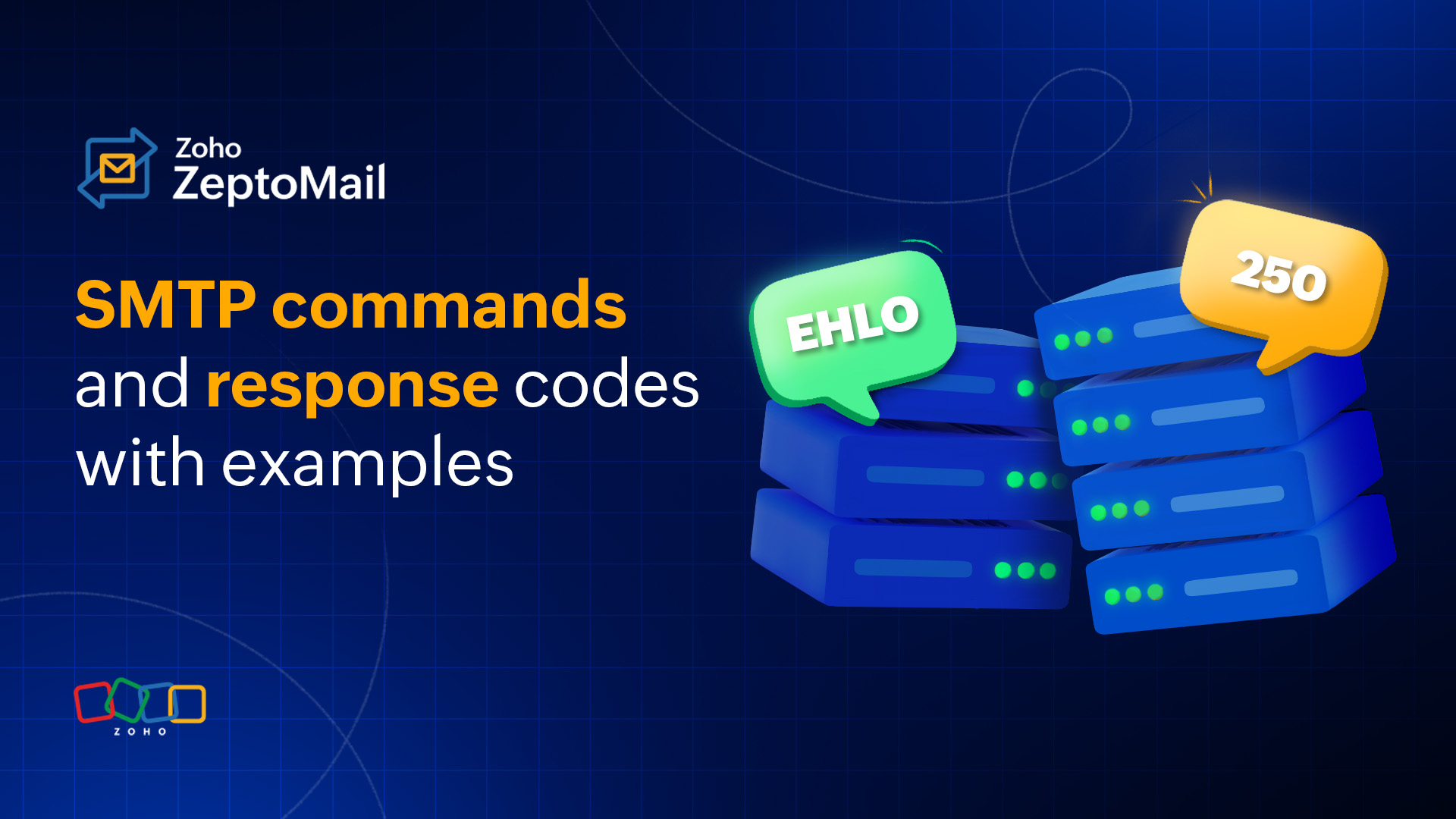- HOME
- Email sending
- A guide to email bounces
A guide to email bounces
- Published : February 16, 2024
- Last Updated : September 22, 2025
- 2.4K Views
- 8 Min Read

Among the large volumes of emails you send, some are bound to bounce. An email bounce occurs when an email is returned to you without being delivered to the intended recipient.
The reason can range from a simple typo in the recipient’s address to email servers completely blocking you out. This is a cause for concern, especially if you’re sending out transactional emails because they need to be delivered on time. A transactional email bounce could mean keeping a customer waiting for their important notifications, like a security code or invoice information. This could exasperate them and affect your brand identity.
Another reason why bounce handling is important is to keep your sender reputation intact. A good sender reputation will make the recipient server trust you and allow emails from you to go through into the user's inbox. This trust results in improved email deliverability, which is essential while sending out transactional emails.
Before getting into the details of email bounces, there are two components of bounces that help you evaluate them, which we explain below.
Email bounce rates
Email bounce rates measure the number of emails that have bounced among the group of emails that were sent to a recipient. The bounce rate can be calculated like this:
(Number of bounced emails/Total emails sent) x 100
This value quantifies your bounces, helping you keep track of and handle them. The accepted bounce rate is 2%. This means that for every 1,000 messages you send, 20 will be returned to you. This value gives some leeway for bounces due to typos or abandoned email addresses, where the bounce isn't really in your control.
The bounce rate percentage holds good for transactional emails too, because they’re high priority and have to be delivered on time every time.
Email bounce codes
Servers that use SMTP to transfer emails between them communicate using certain codes. These codes are used to grant permission for a certain action and also to return the statuses of the emails. So, when an email bounces, these servers indicate that using bounce codes. You’ll be able to view these codes in the bounced email itself.
Previously, bounce codes were represented as three-digit numbers, like 421. Codes that start with 4 were said to be a soft bounce, while those that start with 5 were considered to be hard bounced.
An enhanced version of this is used now, where the digits are separated using a period. This was done to give deep clarity on the reason for the bounces.
- 2.X.X indicates successful email delivery.
- 4.X.X indicates a soft bounce.
- 5.X.X indicates a hard bounce.
The second digit indicates the category in which the bounce falls. For example, X.1.X indicates that there was an issue with the email address.
The third digit gives the exact reason for the bounce. For example, X.1.1 shows that the mailbox specified in the address is incorrect. In other words, the portion before the @ is incorrect. A detailed list of these error codes can be found here.
Bounce code statuses come in handy when tackling your transactional email bounces. These metrics provide the insight you need to solve them efficiently.
To understand how resolving bounces improves your inbox placement, we need to understand the relation between bounces and email deliverability.
Email bounce and deliverability
Repeated bounces for emails from the sender will result in the receiving server blacklisting the sending domain. In addition to this, if your emails are marked as spam or are caught in the recipient's spam filters, your domain reputation will plummet.
Domain reputation is the metric based on which the receiver judges your domain. In addition to this, recipient servers also evaluate the sender's IP. The domain, IP, and some other factors work together to form a sender's reputation.
When an email bounces, the sender's reputation takes a hit. This leads to the receiver perceiving the sender as untrustworthy. As a result, they either delay the inbox placement or, in the worst-case scenario, block emails altogether, negatively affecting the deliverability rates. Transactional emails are required to be delivered on time, and any delays will leave the customer perplexed, if not suspicious.
So, keeping your bounces in check is an important part of your transactional email delivery. You can do this depending on the type of bounce your email encounters.
Handling email bounces is a small part of improving your deliverability. A holistic approach is the key to achieve greater deliverability.
Types of email bounces
Emails can bounce due to various reasons, which are broadly classified into two categories.
- Hard bounces
- Soft bounces
- Others
Hard bounce
A hard bounce occurs when the email is undeliverable to the recipient and would likely remain so. Hard bounces occur due to permanent reasons, meaning the cause for bounce cannot be changed. These bounces can occur due to an invalid email address, when the receiving server is no longer functioning, or there’s a typo in the domain or recipient’s address. Email service providers usually terminate email sending to addresses causing a hard bounce.
Some of the reasons your transactional emails might intercept a hard bounce are discussed below.
User not found
This error arises when the email address no longer exists in the recipient server. One possible reason could be that the recipient closed their email account. In cases of work emails, the user could have switched jobs. In this case, it’s important to immediately suspend email sending to these email addresses.
Policy failures
Some email servers have policies that block list emails coming from certain email addresses or IPs. Some servers bounce emails coming from IPs or domains that they perceive as new. This is a precautionary measure to protect themselves against spam. If you’re in this unfortunate list, you can contact the server and ask to be added to their list of trusted domains and IPs.
Misspelled addresses
Human error can always get in the way of a well-intended email. In this case, the error could be on the recipient's side, and you can’t do much about it. This error occurs when the recipient may have misspelled the email address. You can avoid these errors by having a double opt-in facility, where the user will be able to rectify their errors.
Poor email authentication
Domain authentication lets the receiving server know that your domain is legitimate. You can do this using three mechanisms: SPF, DKIM, and DMARC. The receiving server checks for these certificates, and if the email doesn't comply with any of these authentication policies, then the server can bounce your email.
Soft bounces
Soft bounces occur due to a temporary issue in the recipient server. Soft bounces are termed as temporary errors because the problem usually clears up in time. Although not as severe as a hard bounce, you should be wary of them because some soft bounces can turn into hard bounces. This occurs after multiple attempts to reach the recipient server. The reasons for a soft bounce are discussed below.
Temporary server error
This error will be encountered when the sender isn’t able to connect with the recipient. This could be due to the temporary unavailability of the recipient server or a network issue. This error usually clears up once the recipient becomes available again.
Mailbox full
A mailbox full error usually indicates that the user's mailbox has reached a threshold of the emails that can be accepted. Once they clear it up, the mailbox will be open to accept emails. This could also be a result of rich media images taking up their space.
Content-related bounce
Certain email providers will be on the lookout for email content that may be suspicious. You can avoid such bounces by staying away from content that could be considered spammy and ensuring that any links you add lead to legitimate websites. Being wary of this bounce is essential because this can easily turn into a hard bounce and affect your deliverability.
Email size
This bounce occurs if your email is too large. Email clients have a cap on the email sizes they receive. Some can be 10MB, while others will accept sizes up to 25MB. Always check the size of the email before you send it, and, if needed, break a bigger email into smaller emails and send them separately.
Server overload
A server overload can occur when the recipient server experiences high volumes of incoming emails. If this persists for a specific email service provider, this could indicate that the server is experiencing high amounts of traffic at specific time in a day. So, adjusting your email sending window accordingly will help you avoid such bounces.
Policy restrictions
Some email clients have policies restricting the rate at which they receive emails. This rate limitations could cause a soft bounce. The emails will eventually be delivered. An important note about this bounce is that the email sending has to be attempted gradually over a period of time.
Others
Spam-related bounces
A separate category that might cause your emails to bounce is when a certain section of your email is identified as spam. Spam errors occur when the sending domain and IP have a low reputation. Transactional emails being marked as spam is a serious issue and should be resolved immediately.
Best practices for email bounces
Transactional email bounces should be constantly monitored to protect your sender reputation. Zoho ZeptoMail provides a consolidated report of all the emails you send, which you can use to evaluate their performance. You can either view the report for all of the emails you send or view only the ones specific to the Mail Agent. In addition to this, bounce categories point out the exact reason for your bounces, which will help you handle them better.
Keep the following in mind when it comes to handling bounces:
- Be on the lookout for hard bounces and aim to immediately terminate email sending to accounts causing these bounces.
- Ensure that you don’t include content or links that can be perceived as spam. These can turn out to be a major reason for hard bounces and can affect your deliverability.
You can further protect your sender reputation by following some best practices.
Suppression list
Hard bounces can wreck havoc on your sender reputation, so it’s essential to handle them immediately. You can eliminate automatic email sending to such addresses by adding them to the suppression list. ZeptoMail automatically adds all of the emails that hard bounce to the suppression list. You can also manually add the addresses to this list. Our guide here will help you get started with the suppression list in ZeptoMail.
Double opt-in
Double opt-in is when a user is asked to verify their email address when they sign up. Typically, an email is sent out once a user signs up that provides a link to confirm the email. Double opt-ins not only eliminate misspelled addresses, but also help you subtly reinforce your brand identity when they interact with you in another platform—their mailbox.
Warming up your domain and IP address
When sending out emails from a new domain, start warming up your domain by gradually increasing your sending volume. This way, the sudden spurt in sending volume won’t shock the receiving server into thinking that you’re a potential spammer. Although receiving servers have a myriad of filters that detect spam, clean IP and domain practices will protect you against bounces. All of the IPs used in ZeptoMail are warmed up to protect your sender reputation. This article gives you more insight on domain reputation and how you can ensure good deliverability.
Wrapping up
Bounces are emails that are returned to you without being delivered to the intended recipient. Although undesirable enough in marketing emails, transactional email bounces can affect your sender reputation and deliverability—the two most important aspects of these emails. General best practices and clean email methods will help you keep bounces as low as possible.

